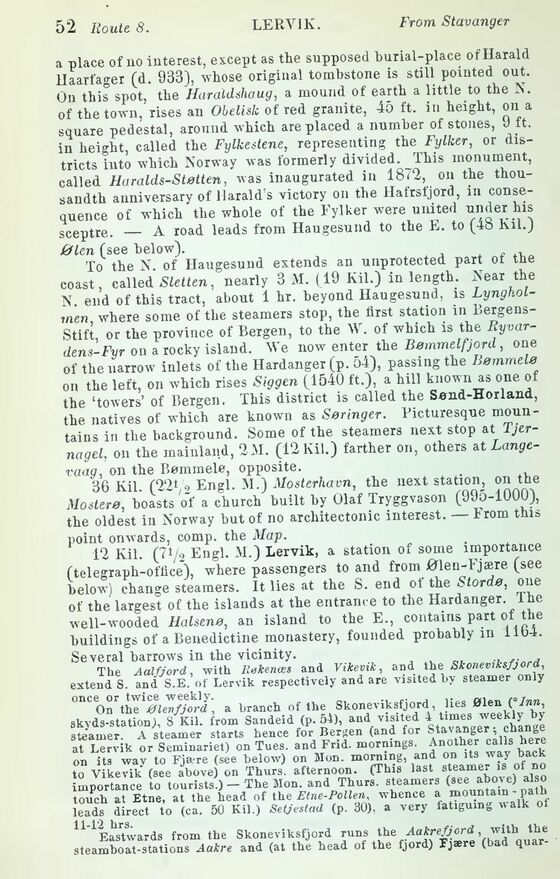
Full resolution (JPEG) - On this page / på denna sida - Norway - Pages ...

<< prev. page << föreg. sida << >> nästa sida >> next page >>
Below is the raw OCR text
from the above scanned image.
Do you see an error? Proofread the page now!
Här nedan syns maskintolkade texten från faksimilbilden ovan.
Ser du något fel? Korrekturläs sidan nu!
This page has never been proofread. / Denna sida har aldrig korrekturlästs.
a place of no interest, except as the supposed burial-place of Harald
Haarfager (d. 933), whose original tombstone is still pointed out.
On this spot, the Haraidshaug, a mound of earth a little to the N.
of the town, rises an Obelisk of red granite, 45 ft. In height, on a
square pedestal, around which are placed a number of stones, J ft.
in height, called the Fylkestene, representing the Fylker, or
districts into which Norway was formerly divided. _This monument,
called Haralds-Støtten, was inaugurated in 1872, on the
thousandth anniversary of llarald’s victory on the Hafrsfjord, m
consequence of which the whole of the Fylker were united under his
sceptre. — A road leads from Haugesund to the E. to (4b kil.J
Ølen (see below). . „
To the N. of Haugesund extends an unprotected part ot tne
coast, called Sletten, nearly 3 M. (19 Kil.) in length. Near the
n| end of this tract, about 1 hr. beyond Haugesund, is
Lynghol-men where some of the steamers stop, the first station in
Bergens-Stift or the province of Bergen, to the ■ of which is the
Ryvar-dens-Fyr on a rocky island. We now enter the Bømmelfjord, one
of the narrow inlets of the Hardanger (p. 54), passing the Bømmelø
on the left, on which rises Siggen (1540 ft.), a hill known as one of
the ‘towers’ of Bergen. This district is called the Sumd-Horland,
the natives of which are known as Søringer. Picturesque
mountains in the background. Some of the steamers next stop at
ljer-nagel, on the mainland, BM. (12 Kil.) farther on, others at Lange-
vaaq, on the Bømmelø, opposite. .
36 Kil. (221,o Engl. M.) Mosterhavn, the next station, on the
Mosterø, boasts I a church built by Olaf Tryggvason (99O-1000),
the oldest in Norway but of no architectonic interest. — From this
point onwards, comp, the Map. .
12 Kil. (71/2 Engl. M.) Lervik, a station oi some importance
(telegraph-office”), where passengers to and from Ølen-Fjære (see
below) change steamers. It lies at the S. end ot the Stordø, one
of the largest of the islands at the entrance to the Hardanger The
well-wooded Halsenø, an island to the E., contains part of the
buildings of a Benedictine monastery, founded probably m llb-4.
Several barrows in the vicinity. .1 .
The A alfjord, with Røkenæs and Vikevik, änå the Skoneviksfjord,
extend S. and S.E. of Lervik respectively and are visited by steamer only
0°“oSrt£ . 2 Of .h. Skoneviksfjord, lies 01.» <V...
skvds-station), 8 Kil. from Sandeid (p. 54), and visited 4 times weekly by
steamer. A steamer starts hence for Bergen (and for Stavanger; change
at Lervik or Seminariet) on Tues. and Fnd. mornings. Another calls here
on its wav to Fia-re (see below) on Mon. morning, and on its wav back
to Vikevik (see above) on Thurs. afternoon. (This last stea’ne71S °f “°
importance to tourists.) - The Mon. and Thurs. steamers (^e ^bo’ e) also
touch at Etne, at the head of the Etne-Pollen, whence a mountain path
leads direct to (ca. 50 Kil.) Seljestad (p. 30), a very fatiguing walk of
^Eastwards from the Skoneviksfjord runs the Aakrefjord , with the
steamboat-stations Aakre and (at the head of the fjord) Fjære (bad quar-
<< prev. page << föreg. sida << >> nästa sida >> next page >>